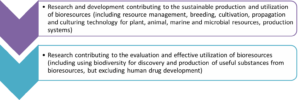BIORESOURCES
Research contributing to sustainable production and utilization of bioresources
Since ancient times, human beings have utilized a diversity of bioresources for energy and to provide the necessities for healthy lives, such as food and fodder, medicine, and textiles. With recent global-level population increases and climate change, there is a need to develop radical, fundamental technology to deal with desertification; drying, salt accumulation and spread of insect pests and viral diseases in agricultural land; less reliable temperature and rainfall levels, etc., all of which threaten the sustainable production of bioresources. In addition, the United Nations Sustainable Development Goals (SDGs) set forth objectives for the utilization of bioresources in Goal 2: End hunger, achieve food security and improved nutrition and promote sustainable agriculture and Goal 14: Conserve and sustainably use the oceans, seas and marine resources for sustainable development.
The Conference of Parties to the Convention on Biological Diversity recognizes that biodiversity supports the existence of humans and provides a variety of benefits to humans. The Convention on Biological Diversity, Nagoya Protocol, and International Treaty on Plant Genetic Resources for Food and Agriculture were established by international agreement, with their objectives being the conservation of biological diversity and the sustainable use of its components, and fair and equitable sharing of benefits arising from genetic resources. The countries that are the parties to the convention are now putting into place the legislative framework to achieve these objectives. Japan ratified the Nagoya Protocol in August 2017, and will henceforth be required to adhere to further international treaties.
In order that we can continue to enjoy the benefits of bioresources in the context of such global change, the importance of research and development into the production, utilization, and management of bioresources, particularly in developing countries, has been identified, and there is growing demand for the rapid deployment of the outcomes of such research to benefit society.
Examples of the list main research subjects:-

*Other subjects are also acceptable if they meet the requirements mentioned above.
*Below are the list of topics that should be under the field of Environment and Energy.
- Research contributing to the conservation and restoration of ecosystems and biodiversity (Environment and Energy)
- Research contributing to the utilization of biomass energy (Bioresources (Environment and Energy) )
- Research activities that primarily address environment and energy issues (Environment and Energy and Bioresources)
